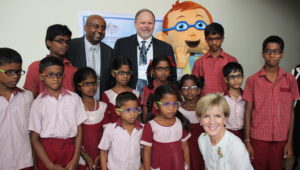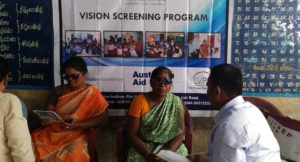An eye for eye health
By Vinod Daniel
Over 100 million people in India have some form of visual impairment or the other. A majority of them would need just a pair of glasses to allow them to be productive. India Vision Institute (IVI), an Australian initiated charity in India, is making a substantial difference to Indians with vision and eye health problems. IVI is the result of coming together of two leading and renowned institutions, the Brien Holden Vision Institute, Sydney and the LV Prasad Eye Institute, Hyderabad. The Sydney-based institute was established by the late Australian visionary optometrist Brien Holden. Dr Holden needs no introduction. He worked tirelessly for vision care delivery and was a crusader in providing quality eye care delivery across the world. Dr Holden was my friend and colleague – as board member ”“ at the Australian government’s Australia-India Council (AIC).
When I was given the opportunity to establish and lead the India Vision Institute, I readily accepted it. For two reasons, first because of my roots and work with the AIC, and secondly, the mind-boggling number of Indians afflicted with the malaise. Soon I found myself shuttling between Sydney and Chennai, which is where IVI’s corporate headquarters is based. Over the last five years we have worked in over 18 Indian states on projects.
India Vision Institute has made a beginning in providing access to vision screening and distributing free spectacles to people in need across India
The problem, no doubt, is huge. But we at IVI are trying to grapple with it, working closely with the local governments, corporate sector and private initiatives providing eye care. IVI has been working through initiatives for vision care, education and skilling optometrists, and integrating vision care delivery with public health. We work closely with global peak bodies such as the World Council of Optometry (WCO) and the Asia Pacific Council of Optometry (APCO), among others. Just this September, IVI partnered with WCO and APCO to co-host the second World Congress of Optometry in Hyderabad, the first time such a major conference on eye health was organised in India. The world congress recognised the strides made by India in Optometry. It adopted a resolution calling for an ”˜Optometry Council’ ”“ as a regulatory mechanism ”“ to be established in India. It is our belief that the Hyderabad conference will act as a catalyst for the promotion and further development of Optometry in India.
IVI’s principal aim is to prevent avoidable blindness through awareness campaigns, vision screening programs and providing capacity building and leadership direction to optometrists.
On 14 September2017, in Chennai, the Australian ODI cricket team presented IVI with two cricket bats signed by the entire team at a reception hosted for them by Australia’s Consul-General for South India, Sean Kelly. The bats were auctioned and IVI raised AUD 8000, which will go towards screening over 7000 children from less privileged backgrounds in and around Chennai. We gratefully acknowledge this gesture by the team and thank the Australian Cricket Board (ACB) for the support.
The two main causes of visual impairment in the world are uncorrected refractive errors, accounting for 42% of visual impairment and cataract at 33%.
The Australian ODI team presented two signed bats to India Vision Institute to assist with vision screen children from less privileged backgrounds in and around Chennai
A refractive error is more common, in fact as estimates show, it is the most common eye disorder. It occurs when the eye cannot clearly focus on images. The result is blurred vision, which can sometimes be so severe as to cause visual impairment.
The most common types of refractive errors are myopia (near-sightedness), hypermetropia (farsightedness), and astigmatism, which leads to difficulty in seeing the distance; reading or seeing at arm’s length; and distorted vision resulting from an imperfection in the curvature of cornea or lens. Another major eye condition is presbyopia (which literally means “aging eye”). It is an age-related eye condition that makes it more difficult to see very close. According to WHO estimates, 153 million people worldwide live with visual impairment due to uncorrected refractive errors. Unlike cataract, refractive errors can easily be treated by a pair of spectacles.
Most people with vision impairment due to uncorrected refractive error in India are underprivileged and do not have access to vision screening or lack awareness. We have seen that often, just a pair of spectacles can do the trick. A study by the Vision Impact Institute states that regularly wearing spectacles will increase the productivity of those affected by 34 % and their wages by 20%.
For a country like India, a population with a large number of visually challenged poses serious problems. India has one of the largest reservoirs of young, employable people in the world. It is expected to become the world’s most populous country in the years to come. Raising the Indian population’s productivity is of paramount importance, and so, correction of refractive errors through a pair of spectacles is something that deserves serious attention by all concerned. Eye health issues among older citizens has also to be viewed with seriousness. It is important for early detection and treatment of cataract rather than for it to reach a stage where serious visual impairment or potential blindness becomes inevitable.
Strengthening eye care services in the country through their integration into the health system has to be a priority. There is a need for comprehensive eye care services to become an integral part of primary health care. An inter-disciplinary approach in health care delivery can address several other issues such as premature birth, vitamin A deficiency, diabetes and smoking.
A critical shortfall in the number of optometrists also needs to be addressed. Ideally, India should have 125,000 optometrists based on the current population but there are unfortunately only 45,000 of them, which is just a third of the requirement. This is where the educational component of healthcare is vital in the context of eye health. Students should be made aware of Optometry as a field of study and encouraged to take it up just like in any other specialty.
Most of IVI’s programs aim to address the need to develop Indian Optometry and ensure sustainable progress of optometry institutions, leadership development among the Optometry cadres, and much more. IVI has made significant achievements in terms of geographical coverage, continuous professional development, establishing required organizational structures and networks, and advocacy and awareness generation. We have worked with over 38 partners through various programs that have benefitted over 4,800 Optometry professionals and spread awareness about the importance of Optometry to millions of individuals among the general public in India.
Vision screenings
Since 2012, IVI has conducted 241 vision screening programs in and around Chennai and other cities in Andhra Pradesh, Telangana, Tamil Nadu, Kerala, Maharashtra, Gujarat, Puducherry, West Bengal, New Delhi and Mizoram. Underprivileged children from government, corporation, municipality schools, orphanages and adults from various underprivileged communities such as gypsies, lepers, fishermen, daily wagers, prison inmates (men, women and juveniles), firecracker makers, beedi makers and auto drivers have undergone vision screening programs through Eye See & I Learn and Eye See & I work campaigns and received free spectacles.
Children are the future of a nation. Eye See & I Learn is a campaign to screen the vision of underprivileged children from schools across India. A child’s education depends primarily on vision as 80% of what a child learns is visually processed. In India, vision impairment from refractive error is a serious problem, affecting 1 in 20 children. which is over a million children who need spectacles but a majority of them do not have access to it given the current scenario. This is a huge problem, but there is a solution. In most cases, a pair of spectacles is all it takes to correct a child’s vision and help them see well.
A small help from our donors can help a child see better, stay in school, learn better and have a chance for a better future. A donation of as small as 90 rupees helps screen the vision of one child and provide free spectacles to those who require them.
The Eye See & I Work campaign screens people from under-privileged backgrounds and provides free spectacles to those who need them. With good, corrected vision, such people are able to lead a useful, productive and normal life.
IVI has screened over 111,837 individuals from the underprivileged communities (including over 73,151 children) and free spectacles distributed to 11,138 individuals (including 5,041 children).
It is with some satisfaction I say that we have made a beginning in providing universal access to vision access, alongside government and other initiatives. The hope of providing a better eye and vision care delivery system can be made a reality.
For supporting India Vision Institute’s initiatives, contact Vinod Daniel at vinod.daniel.am@gmail.com
or go tohttp://www.indiavisioninstitute.org/donate-now.phpto see how you can make a donation.
Visit institute website at
(The author is CEO, India Vision Institute.)
Short URL: https://indiandownunder.com.au/?p=10060


